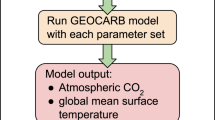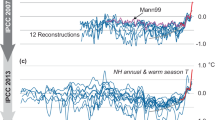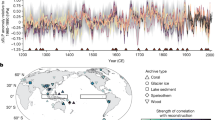Abstract
Many palaeoclimate studies have quantified pre-anthropogenic climate change to calculate climate sensitivity (equilibrium temperature change in response to radiative forcing change), but a lack of consistent methodologies produces a wide range of estimates and hinders comparability of results. Here we present a stricter approach, to improve intercomparison of palaeoclimate sensitivity estimates in a manner compatible with equilibrium projections for future climate change. Over the past 65 million years, this reveals a climate sensitivity (in K W−1 m2) of 0.3–1.9 or 0.6–1.3 at 95% or 68% probability, respectively. The latter implies a warming of 2.2–4.8 K per doubling of atmospheric CO2, which agrees with IPCC estimates.
This is a preview of subscription content, access via your institution
Access options
Subscribe to this journal
Receive 51 print issues and online access
$199.00 per year
only $3.90 per issue
Buy this article
- Purchase on Springer Link
- Instant access to full article PDF
Prices may be subject to local taxes which are calculated during checkout



Similar content being viewed by others
Change history
16 January 2013
Nature 491, 683–691 (2012); doi:10.1038/nature11574 The surname of author V. Masson-Delmotte was misspelled as Masson-Demotte. In Table 1 of this Perspective, the ‘Source’ for ‘Label in Fig. 3’ entry 13 should be ref. 61 (not ref. 65). In addition, the x-axis labels of Fig. 3c were misplaced. Figure1 shows the corrected panel and the original Perspective has been corrected online.
References
Solomon, S., et al., eds. Climate Change 2007: The Physical Science Basis (Cambridge Univ. Press, 2007)
Knutti, R. & Hegerl, G. C. The equilibrium sensitivity of the Earth’s temperature to radiation changes. Nature Geosci. 1, 735–743 (2008). Presents a synthesis of equilibrium climate sensitivity estimates and discusses challenges for constraining its upper limit.
Houghton, J. T., et al., eds. Climate Change 2001: The Scientific Basis (Cambridge Univ. Press, 2001)
Roe, G. H. Feedbacks, timescales and seeing red. Annu. Rev. Earth Planet. Sci. 37, 93–115 (2009)
Dufresne, J.-L. & Bony, S. An assessment of the primary sources of spread of global warming estimates from coupled atmosphere-ocean models. J. Clim. 21, 5135–5144 (2008). Presents a compilation of results of 12 GCMs used in IPCC-AR4, on the contribution of different fast feedbacks to both equilibrium and transient temperature change.
Köhler, P. et al. What caused Earth’s temperature variations during the last 800,000 years? Data-based evidences on radiative forcing and constraints on climate sensitivity. Quat. Sci. Rev. 29, 129–145 (2010). Presents a data compilation on radiative forcing over the past 800 kyr, which forms the backbone of our late Pleistocene examples in Table 2 and in Supplementary Information.
Roe, G. H. & Baker, M. B. Why is climate sensitivity so unpredictable? Science 318, 629–632 (2007)
Baker, M. B. & Roe, G. H. The shape of things to come: why is climate change so predictable? J. Clim. 22, 4574–4589 (2009)
Hannart, A., Dufresne, J.-L. & Naveau, P. Why climate sensitivity may not be so unpredictable. Geophys. Res. Lett. 36, L16707 (2009)
Zaliapin, I. & Ghil, M. Another look at climate sensitivity. Nonlinear Process. Geophys. 17, 113–122 (2010)
Colman, R. & McAvaney, B. Climate feedbacks under a very broad range of forcing. Geophys. Res. Lett. 36, L01702 (2009)
Hargreaves, J. C., Abe-Ouchi, A. & Annan, J. D. Linking glacial and future climates through an ensemble of GCM simulations. Clim. Past 3, 77–87 (2007)
Lunt, D. J. et al. On the causes of mid-Pliocene warmth and polar amplification. Earth Planet. Sci. Lett. 321–322, 128–138 (2012)
Haywood, A. M. et al. Are there pre-Quaternary geological analogues for a future greenhouse warming? Phil. Trans. R. Soc. A 369, 933–956 (2011)
Edwards, T. L., Crucifix, M. & Harrison, S. P. Using the past to constrain the future: how the palaeorecord can improve estimates of global warming. Prog. Phys. Geogr. 31, 481–500 (2007)
Crucifix, M. Does the Last Glacial Maximum constrain climate sensitivity? Geophys. Res. Lett. 33, L18701 (2006). Presents first key evidence on the state-dependence of climate sensitivity.
Laîné, A., Kageyama, M., Braconnot, P. & Alkama, R. Impact of greenhouse gas concentration changes on the surface energetics in the IPSL-CM4 model: regional warming patterns, land/sea warming ratio, glacial/interglacial differences. J. Clim. 22, 4621–4635 (2009)
Otto-Bliesner, B. L. Status of CCSM4 Paleo CMIP5 Climate Simulations. http://www.cesm.ucar.edu/events/ws.2011/Presentations/Paleo/bette.pdf
Held, I. M. et al. Probing the fast and slow components of global warming by returning abruptly to preindustrial forcing. J. Clim. 23, 2418–2427 (2010)
Joos, F. & Spahni, R. Rates of change in natural and anthropogenic radiative forcing over the past 20,000 years. Proc. Natl Acad. Sci. USA 105, 1425–1430 (2008)
Köhler, P., Knorr, G., Buiron, D., Lourantou, A. & Chapellaz, J. Abrupt rise in atmospheric CO2 at the onset of the Bølling/Allerød: in-situ ice core data versus true atmospheric signals. Clim. Past 7, 473–486 (2011)
Hönisch, B. et al. The geological record of ocean acidification. Science 335, 1058–1063 (2012)
Charney, J. G. et al. Carbon Dioxide and Climate: A Scientific Assessment (National Academy of Sciences, 1979)
Knutti, R. & Tomassini, L. Constraints on the transient climate response from observed global temperature and ocean heat uptake. Geophys. Res. Lett. 35, L09701 (2008)
Gregory, J. M. & Forster, P. M. Transient climate response estimated from radiative forcing and observed temperature change. J. Geophys. Res. 113, D23105 (2008)
Soden, B. J. & Held, I. M. An assessment of climate feedbacks in coupled ocean-atmosphere models. J. Clim. 19, 3354–3360 (2006)
Huber, M., Mahlstein, I., Wild, M., Fasullo, J. & Knutti, R. Constraints on climate sensitivity from radiation patterns in climate models. J. Clim. 24, 1034–1052 (2011)
Huybers, P. Compensation between model feedbacks and curtailment of climate sensitivity. J. Clim. 23, 3009–3018 (2010)
Lemoine, D. M. Climate sensitivity distributions dependence on the possibility that models share biases. J. Clim. 23, 4395–4415 (2010)
Hansen, J. Sato, M. Kharecha, P. & von Schuckmann, K. Earth’s energy imbalance and implications. Atmos. Chem. Phys. 11, 13421–13449 (2011)
Gregory, J. M. et al. A new method for diagnosing radiative forcing and climate sensitivity. Geophys. Res. Lett. 31, L03205 (2004)
Lambert, F. et al. Dust-climate couplings over the past 800,000 years from the EPICA Dome C ice core. Nature 452, 616–619 (2008)
Winckler, G., Anderson, R. F., Fleisher, M. Q., McGee, D. & Mahowald, N. Covariant glacial-interglacial dust fluxes in the equatorial Pacific and Antarctica. Science 320, 93–96 (2008)
Roberts, A. P., Rohling, E. J., Grant, K. M., Larrasoaña, J. C. & Liu, Q. Atmospheric dust variability from major global source regions over the last 500,000 years. Quat. Sci. Rev. 30, 3537–3541 (2011)
Ruth, U., Wagenbach, D., Steffensen, J. P. & Bigler, M. Continuous record of microparticle concentration and size distribution in the central Greenland NGRIP ice core during the last glacial period. J. Geophys. Res.. 108, 4098, http://dx.doi.org/10.1029/2002JD002376 (2003)
Naafs, B. D. A. et al. Strengthening of North American dust sources during the late Pliocene (2.7 Ma). Earth Planet. Sci. Lett. 317–318, 8–19 (2012)
Kohfeld, K. E. & Harrison, S. P. DIRTMAP: the geological record of dust. Earth Sci. Rev. 54, 81–114 (2001)
Mahowald, N., Albani, S., Engelstaedter, S., Winckler, G. & Goman, M. Model insight into glacial-interglacial paleodust records. Quat. Sci. Rev. 30, 832–854 (2011)
Rohling, E. J., Medina-Elizalde, M., Shepherd, J. G., Siddall, M. & Stanford, J. D. Sea surface and high-latitude temperature sensitivity to radiative forcing of climate over several glacial cycles. J. Clim. 25, 1635–1656 (2012)
Gray, L. J. et al. Solar influences on climate. Rev. Geophys. 48, RG4001 (2010)
Milankovitch, M. Kanon der Erdbestrahlung und seine Anwendung auf das Eiszeitenproblem (Special Publication 133, Mathematics and Natural Sciences Section, Royal Serbian Academy, Belgrade, 1941)
Berger, A. Support for the astronomical theory of climatic change. Nature 269, 44–45 (1977)
Laskar, J. et al. A long-term numerical solution for the insolation quantities of the Earth. Astron. Astrophys. 428, 261–285 (2004)
Lunt, D. J. et al. Earth system sensitivity inferred from Pliocene modelling and data. Nature Geosci. 3, 60–64 (2010). Presents a definition of Earth system sensitivity that includes both fast and slow processes, and its application to the Pliocene.
Gregory, J. & Webb, M. Tropospheric adjustment induces a cloud component in CO2 forcing. J. Clim. 21, 58–71 (2008)
Lüthi, D. et al. High-resolution CO2 concentration record 650,000−800,000 years before present. Nature 453, 379–382 (2008)
Loulergue, L. et al. Orbital and millennial-scale features of atmospheric CH4 over the past 800,000 years. Nature 453, 383–386 (2008)
Schilt, A. et al. Glacial-interglacial and millennial-scale variations in the atmospheric nitrous oxide concentration during the last 800,000 years. Quat. Sci. Rev. 29, 182–192 (2010)
Waelbroeck, C. et al. Sea-level and deep water temperature changes derived from benthic foraminifera isotopic records. Quat. Sci. Rev. 21, 295–305 (2002)
Rohling, E. J. et al. Antarctic temperature and global sea level closely coupled over the past five glacial cycles. Nature Geosci. 2, 500–504 (2009)
Bintanja, R., van de Wal, R. & Oerlemans, J. Modelled atmospheric temperatures and global sea levels over the past million years. Nature 437, 125–128 (2005)
Hansen, J. et al. Target atmospheric CO2: where should humanity aim? Open Atmos. Sci. J. 2, 217–231 (2008)
Imbrie, J. & Imbrie, J. Z. Modeling the climatic response to orbital variations. Science 207, 943–953 (1980)
Huybers, P. & Denton, G. H. Antarctic temperature at orbital timescales controlled by local summer duration. Nature Geosci. 1, 787–792 (2008)
Huybers, P. Early Pleistocene glacial cycles and the integrated summer insolation forcing. Science 313, 508–511 (2006)
Beerling, D. J. & Royer, D. L. Fossil plants as indicators of the Phanerozoic global carbon cycle. Annu. Rev. Earth Planet. Sci. 30, 527–556 (2002)
Pagani, M., Zachos, J. C., Freeman, K. H., Tipple, B. & Bohaty, S. Marked decline in atmospheric carbon dioxide concentrations during the Paleogene. Science 309, 600–603 (2005)
Hönisch, B., Hemming, N. G., Archer, D., Siddall, M. & McManus, J. F. Atmospheric carbon dioxide concentration across the mid-Pleistocene transition. Science 324, 1551–1554 (2009)
Lowenstein, T. K. & Demicco, R. V. Elevated Eocene atmospheric CO2 and its subsequent decline. Science 313, 1928 (2006)
Beerling, D. J. & Royer, D. L. Convergent Cenozoic CO2 history. Nature Geosci. 4, 418–420 (2011)
van de Wal, R. S. W., de Boer, B., Lourens, L. J., Köhler, P. & Bintanja, R. Reconstruction of a continuous high-resolution CO2 record over the past 20 million years. Clim. Past 7, 1459–1469 (2011). Compiles CO 2 data from a variety of approaches over the past 20 million years, and condenses these into one time series.
Beerling, D. J., Fox, A., Stevenson, D. S. & Valdes, P. J. Enhanced chemistry-climate feedbacks in past greenhouse worlds. Proc. Natl Acad. Sci. USA 108, 9770–9775 (2011)
de Boer, B., van de Wal, R. S. W., Lourens, L. J. & Bintanja, R. Transient nature of the Earth’s climate and the implications for the interpretation of benthic δ18O records. Palaeogeogr. Palaeoclimatol. Palaeoecol. 335–336, 4–11 (2011)
Cramer, B. S., Miller, K. G., Barrett, P. J. & Wright, J. D. Late Cretaceous-Neogene trends in deep ocean temperature and continental ice volume: reconciling records of benthic foraminiferal geochemistry (δ18O and Mg/Ca) with sea level history. J. Geophys. Res. 116, C12023 (2011)
Gasson, E. et al. Exploring uncertainties in the relationship between temperature, ice volume and sea level over the past 50 million years. Rev. Geophys. 50, RG1005 (2012)
Zachos, J., Pagani, M., Sloan, L., Thomas, E. & Billups, K. Trends, rhythms, and aberrations in global climate 65 Ma to present. Science 292, 686–693 (2001)
Miller, K. G., Wright, J. D. & Browning, J. V. Visions of ice sheets in a greenhouse world. Mar. Geol. 217, 215–231 (2005)
Sluijs, A. et al. Eustatic variations during the Paleocene-Eocene greenhouse world. Paleoceanography 23, PA4216 (2008)
Dickens, G. R., Castillo, M. M. & Walker, J. C. G. A blast of gas in the latest Paleocene: simulating first-order effects of massive dissociation of oceanic methane hydrate. Geology 25, 259–262 (1997)
Lourens, L. J. et al. Astronomical pacing of late Palaeocene to early Eocene global warming events. Nature 435, 1083–1087 (2005)
Zachos, J. C., Dickens, G. R. & Zeebe, R. E. An early Cenozoic perspective on greenhouse warming and carbon-cycle dynamics. Nature 451, 279–283 (2008)
Zeebe, R. E., Zachos, J. C. & Dickens, G. R. Carbon dioxide forcing alone insufficient to explain Palaeocene-Eocene Thermal Maximum warming. Nature Geosci. 2, 576–580 (2009)
Huber, M. & Caballero, R. The early Eocene equable climate problem revisited. Clim. Past 7, 603–633 (2011)
Lorius, C., Jouzel, J., Raynaud, D., Hansen, J. & Le Treut, H. The ice-core record: climate sensitivity and future greenhouse warming. Nature 347, 139–145 (1990)
Masson-Delmotte, V. et al. Past and future polar amplification of climate change: climate model intercomparisons and ice-core constraints. Clim. Dyn. 26, 513–529 (2006)
Lea, D. The 100000-yr cycle in tropical SST, greenhouse gas forcing, and climate sensitivity. J. Clim. 17, 2170–2179 (2004)
Hansen, J. et al. Climate change and trace gases. Phil. Trans. R. Soc. Lond. A 365, 1925–1954 (2007)
Bijl, P. K. et al. Transient Middle Eocene atmospheric CO2 and temperature variations. Science 330, 819–821 (2010)
Schmittner, A. et al. Climate sensitivity estimated from temperature reconstructions of the Last Glacial Maximum. Science 334, 1385–1388 (2011)
Rohling, E. J. Progress in palaeosalinity: overview and presentation of a new approach. Paleoceanography 22, PA3215 (2007)
MARGO project members. Constraints on the magnitude and patterns of ocean cooling at the Last Glacial Maximum. Nature Geosci. 2, 127–132 (2009)
Schneider von Deimling, T., Ganopolski, A., Held, H. & Rahmstorf, S. How cold was the Last Glacial Maximum? Geophys. Res. Lett. 33, L14709 (2006)
Ballantyne, A. P., Lavine, M., Crowley, T. J., Liu, J. & Baker, P. B. Meta-analysis of tropical surface temperatures during the Last Glacial Maximum. Geophys. Res. Lett. 32, L05712 (2005)
Hansen, J. et al. in Climate Processes and Climate Sensitivity (eds Hansen, J. & Takahashi, T. ) 130–163 (Geophysical Monographs 29, American Geophysical Union, 1984)
Hansen, J. E. & Sato, M. in Climate Change: Inferences from Paleoclimate and Regional Aspects (eds Berger, A., Mesinger, F. & Šijački, D. ) 21–48 (Springer, 2012)
Hoffert, M. I. & Covey, C. Deriving global climate sensitivity from palaeoclimate reconstructions. Nature 360, 573–576 (1992)
Pagani, M., Liu, Z., LaRiviere, J. & Ravelo, A. C. High Earth-system climate sensitivity determined from Pliocene carbon dioxide concentrations. Nature Geosci. 3, 27–30 (2010)
Covey, C., Sloan, L. C. & Hoffert, M. I. Paleoclimate data constraints on climate sensitivity: the paleocalibration method. Clim. Change 32, 165–184 (1996)
Zachos, J. C., Stott, L. D. & Lohmann, K. C. Evolution of early Cenozoic marine temperatures. Paleoceanography 9, 353–387 (1994)
Sloan, L. C. & Barron, E. J. A comparison of Eocene climate model results to quantified paleoclimatic interpretations. Palaeogeogr. Palaeoclimatol. Palaeoecol. 93, 183–202 (1992)
Berner, R. A. A model for atmospheric CO2 over Phanerozoic time. Am. J. Sci. 291, 339–376 (1991)
Freeman, K. H. & Hayes, J. M. Fractionation of carbon isotopes by phytoplankton and estimates of ancient CO2 levels. Glob. Biogeochem. Cycles 6, 185–198 (1992)
Cerling, T. E. Carbon dioxide in the atmosphere; evidence from Cenozoic and Mesozoic paleosols. Am. J. Sci. 291, 377–400 (1991)
Royer, D. L., Pagani, M. & Beerling, D. J. Geobiological constraints on Earth system sensitivity to CO2 during the Cretaceous and Cenozoic. Geobiology 10, 298–310 (2012)
Panchuk, K., Ridgwell, A. & Kump, L. R. Sedimentary response to Paleocene-Eocene Thermal Maximum carbon release: a model-data comparison. Geology 36, 315–318 (2008)
Borzenkova, I. I. Determination of global climate sensitivity to the gas composition of the atmosphere from paleoclimatic data. Izv. Atmos. Ocean. Phys. 39, 197–202 (2003)
Park, J. & Royer, D. L. Geologic constraints on the glacial amplification of Phanerozoic climate sensitivity. Am. J. Sci. 311, 1–26 (2011)
Schmidt, G. A. Climate sensitivity — how sensitive is Earth’s climate to CO2; past. PAGES News 20, 11 (2012)
Wunsch, C. & Heimbach, P. How long to oceanic tracer and proxy equilibrium? Quat. Sci. Rev. 27, 637–651 (2008)
Acknowledgements
This Perspective arose from the first PALAEOSENS workshop in March 2011. We thank the Royal Netherlands Academy of Arts and Sciences (KNAW) for funding and hosting this workshop in Amsterdam, PAGES for their support, and J. Gregory for discussions. This study was supported by the UK-NERC consortium iGlass (NE/I009906/1), and 2012 Australian Laureate Fellowship FL120100050. D.J.B., E.J.R. and P.V. were supported by Royal Society Wolfson Research Merit Awards. A.S. thanks the European Research Council for ERC starting grant 259627, and M.H. acknowledges NSF P2C2 grant 0902882. Some of the work was supported by grant 243908 ‘Past4Future’ of the EU’s seventh framework programme; this is Past4Future contribution number 30.
Author information
Authors and Affiliations
Consortia
Contributions
E.J.R., A.S. and H.A.D. initiated the PALAEOSENS workshop, and led the drafting of this study together with P.K., A.S.v.d.H. and R.S.W.v.d.W. The other authors contributed specialist insights, discussions and feedback.
Corresponding author
Ethics declarations
Competing interests
The author declare no competing financial interests.
Supplementary information
Supplementary Information
This file contains Supplementary Text and Data, Supplementary References, Supplementary Table 1 and Supplementary Figures 1-6. (PDF 4926 kb)
Rights and permissions
About this article
Cite this article
PALAEOSENS Project Members. Making sense of palaeoclimate sensitivity. Nature 491, 683–691 (2012). https://doi.org/10.1038/nature11574
Received:
Accepted:
Published:
Issue Date:
DOI: https://doi.org/10.1038/nature11574
This article is cited by
-
Last glacial hydroclimate variability in the Yucatán Peninsula not just driven by ITCZ shifts
Scientific Reports (2023)
-
Impacts of the PMIP4 ice sheets on Northern Hemisphere climate during the last glacial period
Climate Dynamics (2023)
-
Warm deep-sea temperatures across Eocene Thermal Maximum 2 from clumped isotope thermometry
Communications Earth & Environment (2022)
-
Late Miocene cooling coupled to carbon dioxide with Pleistocene-like climate sensitivity
Nature Geoscience (2022)
-
Climate Sensitivity and Ecoclimate Sensitivity: Theory, Usage, and Past Implications for Future Biospheric Responses
Current Climate Change Reports (2022)
Comments
By submitting a comment you agree to abide by our Terms and Community Guidelines. If you find something abusive or that does not comply with our terms or guidelines please flag it as inappropriate.




